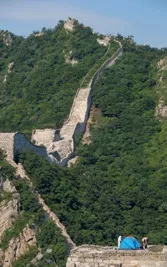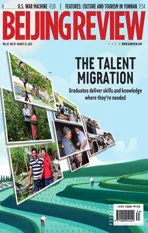Who Should Be Held Accountable for Tragedy in Undeveloped Scenic Spots?
2022-08-24
Flash floods hitting Longcaogou in Pengzhou, Sichuan Province,on August 13 killed seven people and injured eight. Local authorities later noted that several tourists, including seniors and children, camping in tents on the dry riverbed were caught off guard by the sudden torrent and failed to get out in time.

Travelers set up their tent on theperilously steep Jiankou section of the Great Wall in Beijing’s Huairou District onJuly 20, 2008. Out of safety considerations,many sections of the Great Wall no longer allow camping or climbing before theirrenovation has been completed
This particular site had been hailed across Chinese social media platforms as a new“holiday hotspot.” Some had even labeled it as the “Longcaogou Scenic Spot” without the approval of local tourism authorities. Attracted by snapshots of the valley’s stunning scenery on lifestyle-sharing platforms Xiaohongshu and Dianping (China’s Yelp), and short video platforms like Douyin (China’s TikTok), many tourists choose to travel to the area, completely unaware of its hidden natural dangers. Local authorities have repeatedly warned tourists against going there, as there is no supporting infrastructure and the place is prone to geological hazards.
But the most recent Longcaogou tragedy isn’t the only one to have occurred at these popular but undeveloped locations in recent years. Many now wonder: Who should be held accountable?
Hu Siqi (www.rednet.cn): Despite multiple warnings, some people still choose to take risks. Bloggers and vloggers are at fault here. They tell potential visitors about the water being very shallow, how there are very few travelers around, and that you don’t need to buy a ticket to access the area. But in reality,locals seldom step into the riverbed, and these bloggers are almost all from other places.
The Longcaogou tragedy is not a rare event. In a bid to get away from the urban noise, more people in recent years have been seeking solace at niche holiday resorts located“in the wild.” But these underdeveloped sites are not just exciting novelties; they can also pose a great danger to those unfamiliar with their surroundings.
When looking for new sites to explore,tourists should rely on more than just social media. They must not blindly follow posts on these platforms, but must also obtain accurate information through official means.
Bloggers and vloggers, then, must take some responsibility. Social media platforms have to work with the relevant authorities to exclude dangerous scenic spots from their content. Tourists insisting on visiting these sites despite repeated warnings should be subject to penalties.
Jiang Cheng (www.thepaper.cn): This tragedy could have been avoided. There are warning signs alongside the river that read“No entry.” Even right before the flash flood hit, a manager of the area could be overheard shouting at tourists to get out of the riverbed immediately, but no one listened.
Nowadays, people are attracted by nature’s wild scenery; warning signs, instead of deterring them from going there, further stimulate their desire to explore the uncharted. Social media posts that play up the beauty and downplay the hidden dangers of such sites only encourage people to go there.
When traveling to wild scenic spots,people must pay more attention to safety. Apps listing Longcaogou as a scenic spot and social media platforms recommending it must correct the information they put out there to prevent similar tragedies from happening. Even if the warning signs are there, many tourists will choose to ignore them, believing scenic spots recommended by formal apps are safe.
Xie Feijun (www.jfdaily.com/news):Longcaogou is situated in an area prone to geological hazards and that’s why local tourism authorities have not developed it into a formal scenic spot yet. Tourists went there mostly because of what they’d seen on social media. To increase traffic, bloggers and online influencers often show off these types of outdoor spots,regardless of the potential risks involved.
More and more people today rush to share their beautiful travel pictures with the world. This raises a question for social media platforms: How to identify whether locations suggested by individual bloggers are safe or not? Platforms must take action and also discourage people from blindly following bloggers’ irresponsible suggestions. BR
